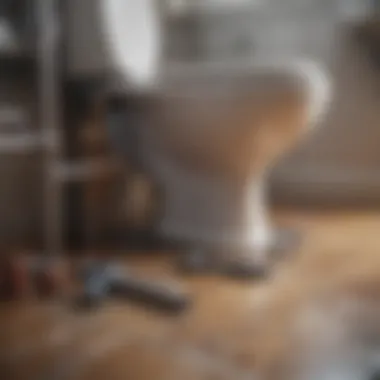Understanding and Resolving Stubborn Toilet Blockage


Intro
Toilet blockage is a prevalent issue that many homeowners encounter at some point. Understanding the underlying causes can help in both resolving the current problem and preventing future occurrences. Clogs hinder drainage, disrupt normal use, and can lead to more significant plumbing issues and costly repairs. In this exploration, we will address how blockages form, identify the signs to watch for, and discuss effective resolution techniques. Proper knowledge and maintenance strategies are important for ensuring your plumbing remains healthy.
Causes of Toilet Blockage
A variety of factors contribute to stubborn blockages. The most common include:
- Excessive Waste: Flushing too much toilet paper or non-flushable items can overwhelm the system.
- Clogged Traps: The toilet's trap can accumulate debris or waste over time, blocking the flow.
- Buildup in Pipes: Mineral deposits and grease can gradually constrict pipe dimensions, restricting wastewater flow.
- Structural Issues: Deterioration or irregularities in pipe structure can create areas prone to clogging.
Symptoms of Blockage
Recognizing the symptoms of a blocked toilet is crucial. Homeowners should be alert to:
- Gurgling sounds during flushing
- Slow drainage in the toilet bowl
- Frequent backups or overflows
Prompt action is essential to mitigate these symptoms before more serious plumbing problems develop.
Effective Solutions
When faced with stubborn toilet blockage, several solutions exist, depending on the severity and cause:
- Plunger Use: This basic tool can effectively dislodge clogs. Employ a flange plunger for the most effective results.
- Plumbing Snake: When plunging fails, a plumbing snake can reach deeper into the plumbing system, breaking apart clogs.
- Chemical Drain Cleaners: While effective in some cases, caution is advised as these can harm plumbing.
- Professional Help: In the case of persistent blockages, contacting a plumber may be necessary to assess potential deeper issues.
Preventive Measures
Preventing toilet blockages begins with mindful habits:
- Avoid flushing non-flushable items like wipes, feminine products, and certain types of paper.
- Regularly maintain your plumbing by inspecting for leaks or buildup.
- Educate family members on proper toilet use to minimize risks.
Blockage issues often signify larger problems within your plumbing system. Address them promptly to avert costly repairs.
End
Prelude to Toilet Blockage
Understanding toilet blockage is essential for maintaining a well-functioning plumbing system in any household. A blocked toilet is more than a mere inconvenience; it can lead to significant issues if not addressed promptly and effectively. As we delve into this topic, it's crucial to recognize the various factors that contribute to toilet blockages and the potential consequences that can arise from neglecting them. This section serves as a primer for readers, providing insights into defining the issue, its implications, and the overall relevance in maintaining a healthy plumbing ecosystem.
Defining Toilet Blockage
Toilet blockage occurs when waste or foreign objects impede the flow of water through the toilet and its associated pipes. This blockage can prevent the toilet from flushing properly, leading to potential overflow or backflow issues. Commonly, blockages arise from an accumulation of material, such as toilet paper, human waste, and sometimes foreign items like toys or sanitary products. The severity of a blockage can vary widely. In some cases, a simple obstruction may cause minor inconveniences, while in others, it can result in a complete plumbing failure.
Why It Matters
Addressing toilet blockage effectively matters for several reasons:
- Health Concerns: Blocked toilets can become breeding grounds for harmful bacteria, presenting health risks to household members.
- Property Damage: Overflows can lead to water damage, ruining floors and walls, and creating additional repair costs.
- Cost Implications: Ignoring a blockage can escalate to more severe plumbing problems, which may require professional interventions at a much higher cost.
"A small drain issue today could turn into a major plumbing disaster tomorrow if left unattended."
In summary, understanding toilet blockage is vital for every homeowner. Recognizing the definition and significance of this plumbing issue creates a foundation for effective prevention and maintenance strategies.
Understanding the Causes of Stubborn Toilet Blockage
Understanding the causes of toilet blockage is vital for homeowners, as it allows them to prevent recurring issues and address problems effectively. A clear grasp of why toilets become blocked helps in making informed decisions about maintenance and repair. Here, we explore various causes that contribute to stubborn blockages, ranging from everyday user habits to systemic plumbing issues. Knowing these elements can bring advantages, such as avoiding costly repairs and ensuring a well-functioning plumbing system.
Common Obstructions
Toilet blockages often stem from common obstructions that accumulate gradually. The most typical culprits include:


- Excessive Toilet Paper: Using too much toilet paper can create clumps that are too large for the plumbing to handle, resulting in blockage.
- Foreign Objects: Items like toys, sanitary products, and wipes that are not designed to be flushed often end up causing significant issues.
- Organic Matter: Accumulation of waste can lead to clogs if the system is not flushing sufficiently.
Each of these obstructions poses risks to the toilet's functionality. Regularly assessing what goes into the toilet can aid in minimizing these risks.
Systemic Plumbing Issues
Sometimes, toilet blockages are not solely due to user actions but are influenced by systemic plumbing issues. A few of these include:
- Pipe Misalignment: Misaligned pipes can inhibit the flow of waste, leading to slow drainage and blockages.
- Tree Root Intrusion: Roots can penetrate sewer systems through small cracks, causing significant blockage over time.
- Old and Corroded Pipes: Aging plumbing systems may corrode, leading to increased friction and reduced diameter for flow, making them prone to blockages.
Awareness of these plumbing issues is crucial. Homeowners should consider regular inspections of their plumbing systems to catch such problems early.
User-Related Factors
User habits play a significant role in the occurrence of toilet blockages. Some common user-related factors include:
- Inappropriate Disposal Practices: Flushing non-flushable materials or disposing of waste in the toilet leads to frequent clogs.
- Underestimating the Problem: Ignoring minor issues or delays in addressing slow drains can allow problems to escalate.
- Improper Use of Cleaning Products: Some chemical cleaners can interact poorly with the plumbing system, causing build-up or damage.
By understanding these user-related factors, individuals can take proactive steps to maintain the toilet and avoid stubborn blockages.
Maintaining a clear understanding of the causes of blockage can empower homeowners to manage their plumbing systems more effectively.
Identifying Symptoms of a Blocked Toilet
Identifying symptoms of a blocked toilet is crucial for effective home maintenance. Recognizing the signs early can save you from more extensive plumbing issues. Understanding the symptoms allows homeowners to take action before the problem escalates, leading to undesirable outcomes such as overflows or severe clogs that require professional intervention.
Changes in Water Level
One of the first symptoms to notice is a change in the water level within the toilet bowl. Typically, the water should remain stable and at a consistent height. If you observe that the water level is unusually high or low, it often indicates a blockage. A high level may mean that waste is not draining properly, while a low level might suggest a leak or other rejection issues in the plumbing system.
Monitoring these variations can help you quickly assess the situation. If ignored, these changes can result in more serious blockages, disrupting your day-to-day activities.
Strange Noises
Strange sounds emanating from the toilet can be a critical warning sign. Gurgling or bubbling noises often suggest that air is trapped in the pipes due to a blockage. This phenomenon happens when waste is unable to flow properly through the plumbing system, causing an echo of movements in the water.
Additionally, high-pitched whistling sounds when flushing may indicate an issue with the flush mechanism itself, or a deeper plumbing problem. Understanding these auditory cues not only aids in the immediate identification of blockages but also indicates the potential severity of an issue that may need to be addressed.
Odors and Drainage Issues
Foul odors are perhaps the most unpleasant symptom of a blocked toilet. If you detect a strong sewage smell, this suggests that waste is stagnant within the pipes and cannot drain effectively. Such odors are not only bothersome but also signify that you may need to inspect your plumbing closely.
Furthermore, sluggish drainage can be a clear indicator of blockage as well. If the water drains slowly during usage, it may signify partial blockage. These conditions require immediate attention. The presence of these odors and slow drainage can escalate into more complex issues, leading to costly repairs and further inconvenience.
Recognizing the symptoms of a blocked toilet can help mitigate worse plumbing troubles. Small signs, if heeded, might prevent major inconveniences later.
By understanding these various symptoms, homeowners can take decisive measures to address potential blockages. Regular observations and responsive actions can significantly enhance plumbing health, ensuring the convenience and comfort of home life.
DIY Solutions for Stubborn Toilet Blockages
The occurrence of stubborn toilet blockages can be frustrating, but several DIY solutions can address these issues effectively. Understanding these solutions is important because they empower homeowners to respond quickly without the need for immediate professional help. This section highlights practical methods that utilize common household items and tools, providing accessible options for those who prefer to take matters into their own hands. By engaging in DIY solutions, you not only save money, but also gain a deeper understanding of your plumbing system.
Baking Soda and Vinegar Method
The combination of baking soda and vinegar is a well-known remedy for various household cleaning tasks, including toilet blockages. This method leverages the chemical reaction produced when the two substances interact, creating a bubbling action that can help dislodge minor clogs.
Steps to Follow:
- Start by pouring a cup of baking soda directly into the toilet bowl.
- Follow this with a cup of vinegar, and let the mixture fizz for about 30 minutes.
- After waiting, flush the toilet to see if the blockage clears.
This method is particularly effective for organic materials, such as small bits of toilet paper or waste. However, it may not be suitable for more severe blockages caused by non-biodegradable items. Furthermore, regularly using this method can have a preventive effect on potential clogs.


Plunging Techniques
Plunging is often the first response many people take when faced with a toilet blockage. A good plunger can be indispensable. It is used to create a vacuum and pressure that can help release the obstruction.
Effective Plunging Tips:
- Ensure there is enough water in the bowl to cover the plunger. This allows for better suction.
- Position the plunger over the drain hole at a slight angle to create an airtight seal.
- Use a firm and steady motion, plunging several times before checking if the water drains properly.
This approach can be very successful for common blockages. However, the technique must be done with care; excessive force may damage the toilet's internal components.
Using a Toilet Auger
A toilet auger is a specialized tool designed to tackle stubborn blockages. It consists of a long, flexible cable with a corkscrew tip and is incredibly effective at reaching deep into the toilet’s plumbing system.
How to Use a Toilet Auger:
- Insert the auger’s tip into the toilet bowl.
- Gently push the cable into the drain until you encounter resistance.
- Twist the auger handle to allow the corkscrew tip to break apart or grab the obstruction, then pull it back out.
- Flush the toilet to check if the blockage is cleared.
While the toilet auger can be quite effective, it requires some practice to use properly. It is crucial not to use excessive force, as this can lead to damage. As with other types of DIY solutions, caution is needed to avoid causing further issues or complications in your plumbing system.
Remember that while DIY methods can be effective, they also require some understanding of potential risks. Assess the situation carefully and proceed with measures that suit the severity of the blockage.
When to Call a Professional Plumber
Toilet blockages can often be resolved with do-it-yourself methods. However, not every situation allows for a simple fix. Recognizing when a blockage requires professional intervention is crucial to prevent further complications. Engaging a plumber at the right moment can save homeowners time, effort, and money.
Recognizing Serious Blockages
Some clogs are more than just a nuisance; they can signify deeper issues within the plumbing system. Here are some indications that a blockage may be serious:
- Persistent Blockages: If a toilet continues to clog after multiple attempts to clear it, this might indicate a serious issue. A recurring problem could suggest that more than just waste is stuck in the pipes.
- Multiple Fixtures Affected: When other fixtures in the home, such as sinks or showers, also have drainage problems, the issue may extend beyond a single toilet. This could mean a main line blockage.
- Sewage Backup: Any sign of sewage coming back up into the toilet or drains is a serious situation. It requires immediate attention to avoid health hazards.
- Unpleasant Odors: If persistent foul smells arise from the toilet or nearby areas, this could signal a blockage or issues with the venting system. It is time to call a professional.
These factors can be indicators of a larger problem that DIY methods cannot resolve. Addressing them quickly with a professional can help maintain the plumbing system's integrity.
Infrastructure Concerns
The infrastructure of a home’s plumbing system is interconnected and complex. When dealing with stubborn toilet blockages, it is essential to consider how blockages might affect other systems:
- Pipe Damage: Long-term blockages can cause pipes to corrode or suffer damage. This can result in leaks or even complete pipe failure. A plumber can inspect the integrity of plumbing elements and recommend necessary repairs.
- Overwhelmed Septic Systems: For homes with septic tanks, repeated clogs may cause septic systems to overflow or malfunction, leading to costly repairs.
- Compliance with Codes: Professional plumbers possess the knowledge to ensure that all repairs and methods comply with local regulations and codes. This ensures that any fixes are up to standard, avoiding potential legal issues down the line.
Preventive Measures for Toilet Blockage
Understanding the implementation of preventive measures for toilet blockages is essential in maintaining a functional and efficient plumbing system. Blockages not only lead to inconvenient inconveniences but also escalate into costly repairs if not managed correctly. Utilizing preventive measures can significantly mitigate the risk of recurring issues, ensuring that toilets function smoothly, thus avoiding the hassle associated with stubborn clogs.
Regular Maintenance Routines
Establishing a routine for toilet maintenance is paramount. Regular checks can prevent minor issues from escalating into significant blockages. This includes inspecting the toilet for leaks, ensuring that the flush mechanism works properly, and monitoring the condition of the toilet bowl and drainage.
Homeowners should also consider periodic deep cleaning using safe detergents. This not only keeps the toilet clean but also helps to dissolve any initial signs of buildup, which can lead to blockages. Additionally, flushing the toilet with hot water can help remove any residue that may be settling in the pipes.
Monitoring Water Use
Keeping an eye on water usage directly contributes to preventing blockages in toilets. Excessive or improper usage can lead to inefficient drainage and increased risks of clogs. Homeowners should be aware of the typical amount of water used for flushes and adjust it where necessary to ensure that the toilet functions efficiently.
Implementing low-flow toilets or dual-flush systems can help in this regard. These fixtures are designed to optimize water usage while maintaining effectiveness. Moreover, being mindful about not overloading the toilet with excessive waste or paper can greatly reduce the frequency of blockages.
Proper Waste Disposal Practices
Understanding what can and cannot be flushed down the toilet is critical. Many people are unaware that some items can cause significant blockages. Items like wipes, feminine hygiene products, and paper towels should never be flushed, as they do not break down easily and can lead to clogs.


Educating all household members on proper disposal practices is important. Providing designated bins for waste that should not go down the toilet can make a significant difference. In essence, encouraging responsible waste disposal can serve as a first line of defense against toilet blockages.
"Implementing preventive measures is not just about avoiding inconvenience; it's about ensuring the longevity and functionality of your plumbing system."
By focusing on these preventive measures, homeowners can significantly reduce the risk of toilet blockages. Maintaining a disciplined approach toward plumbing care is always less expensive and stressful than handling stubborn blockages.
Understanding Plumbing Systems
A comprehensive understanding of plumbing systems is crucial in managing toilet blockages effectively. This sets the foundation for recognizing issues early and using appropriate methods for resolution. Moreover, a solid grasp of the plumbing layout can enhance prevention strategies, possibly avoiding costly repairs in the future. Knowledge of plumbing systems empowers homeowners, allowing for informed decisions when faced with plumbing challenges.
Basic Components of Toilet Plumbing
To fully appreciate how to resolve stubborn toilet blockages, it is essential to understand the basic components of toilet plumbing. The key parts include:
- Toilet Bowl: The bowl holds water and waste.
- Flush Tank: This tank stores water that flushes waste away when activated.
- Flapper Valve: Located at the bottom of the tank, this valve releases water into the bowl during flushing.
- Overflow Tube: This ensures excess water flows back into the tank instead of overflowing.
- Supply Line: The pipe that connects the flush tank to the water supply source.
These components work together to ensure the smooth operation of a toilet. Understanding them helps in diagnosing issues contributing to blockages.
Common Plumbing Designs
Various designs exist in residential plumbing, impacting how blockages form and how they can be resolved. Recognizing these designs can aid in pinpointing potential problems. Some common designs include:
- Gravity Flushing Systems: These rely on gravity for water movement. They are the most common and often straightforward to maintain.
- Pressure-Assisted Systems: These use air pressure to forcefully flush waste. They are more efficient but may complicate repairs due to their complexity.
- Dual Flush Systems: These allow users to choose between a full or half flush, promoting water conservation.
Each design has its advantages and disadvantages, affecting not only flushing effectiveness but also how clogs might arise. Understanding these elements aids in mitigating future plumbing issues effectively.
Impact of Stubborn Blockages on Plumbing Infrastructure
Understanding the impact of stubborn blockages on plumbing infrastructure is crucial. Toilet blockages can lead to significant issues that affect both the functionality and longevity of plumbing systems. The implications go beyond mere inconvenience. Ignoring or improperly addressing a blockage can result in severe damage.
Potential Damage Risks
Stubborn blockages may cause various risks to plumbing. When a toilet is clogged, the pressure builds up in the pipes. This pressure can lead to:
- Cracked Pipes: Excessive pressure can cause pipes to crack or even burst. Once this happens, repairs are costly and labor-intensive.
- Leaking Seals: Blockages can force water through seals in the plumbing system. This causes leaks which further compromise the system's integrity.
- Backflow Problems: A severe blockage can create backflow, bringing waste or contaminated water into the home. This situation poses health risks and requires immediate remediation.
Regular monitoring and maintenance can help mitigate these risks. Homeowners should learn to recognize early warning signs to prevent escalation. For more information, consider the resources at Wikipedia and Britannica.
Cost Implications for Homeowners
The financial impact of plumbing problems resulting from toilet blockages cannot be overlooked. Repairing damage caused by blockages can be very costly. Among the financial factors to consider:
- Repair Costs: The expense of repairing damaged pipes, seals, or toilets can be significant. This includes labor and material costs.
- Increased Utility Bills: Repairs and leaks can lead to higher water bills. Homeowners may not notice a rise until it has become substantial.
- Potential Loss of Property Value: A faulty plumbing system can diminish property value. Buyers may be wary of homes with a history of plumbing issues, including stubborn blockages.
Homeowners are encouraged to adopt preventive measures to minimize these costs. These include regular inspections and implementing proper disposal practices.
"Preventive care and regular maintenance are often more effective than costly repairs after damage has occurred."
Addressing stubborn blockages requires diligence and understanding. Recognizing the potential damage risks and associated costs is vital for responsible homeownership.
Finale
In this article, we explored various aspects of stubborn toilet blockages, emphasizing the importance of understanding and resolving these issues effectively. Toilets are critical fixtures in any home, and blockages can lead to significant inconveniences and potential damage if not addressed promptly. The key benefits of grasping the nuances of toilet blockages include better maintenance, cost savings, and prevention of larger plumbing problems that can escalate quickly.
Summary of Key Takeaways
To encapsulate the essential insights from our discussion:
- Understanding Causes: Identify common obstructions, systemic issues, and user-related factors.
- Symptoms Awareness: Recognizing changes in water levels, unusual sounds, and odors can help in early detection.
- DIY Solutions: Employ methods like baking soda and vinegar, proper plunging techniques, and toilet augers for immediate issues.
- Professional Help: Know when to consult a plumber, especially for severe or systemic problems.
- Preventive Approaches: Regular maintenance, monitoring usage, and practicing responsible waste disposal are vital for ensuring a blockage-free toilet.
Final Thoughts on Maintenance and Care
To maintain your toilet in optimal condition, a proactive approach is essential. This includes:
- Routine Checks: Perform regular inspections of the plumbing system to catch minor issues before they escalate.
- Educate Household Members: Ensure everyone understands what can and cannot be flushed to minimize user-related problems.
- Keep Tools Handy: Have basic plumbing tools at your disposal for quick fixes before they become larger issues.
Through careful attention and maintenance, the discomfort and expense associated with toilet blockages can be significantly reduced. This approach fosters a healthier plumbing system and enhances the overall functionality of your home.















